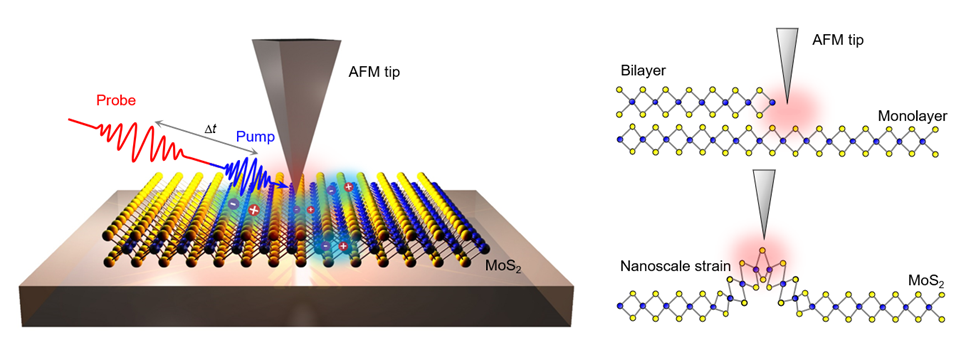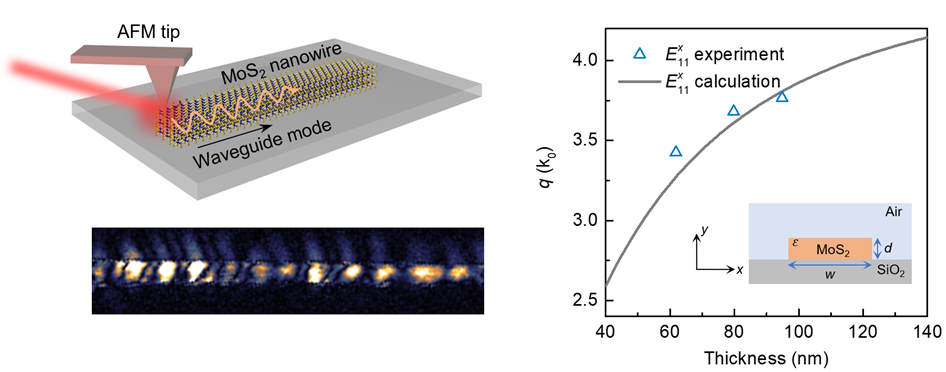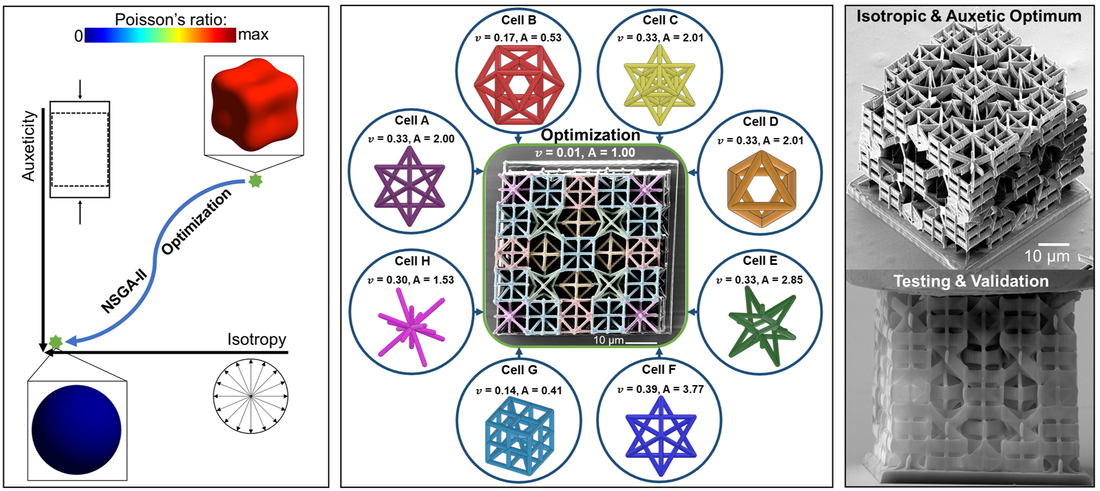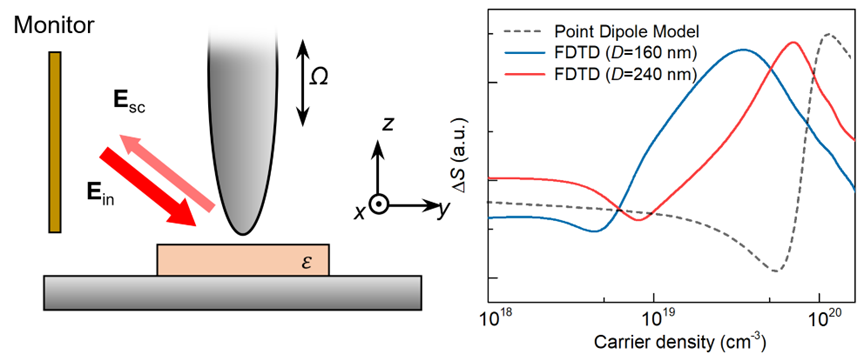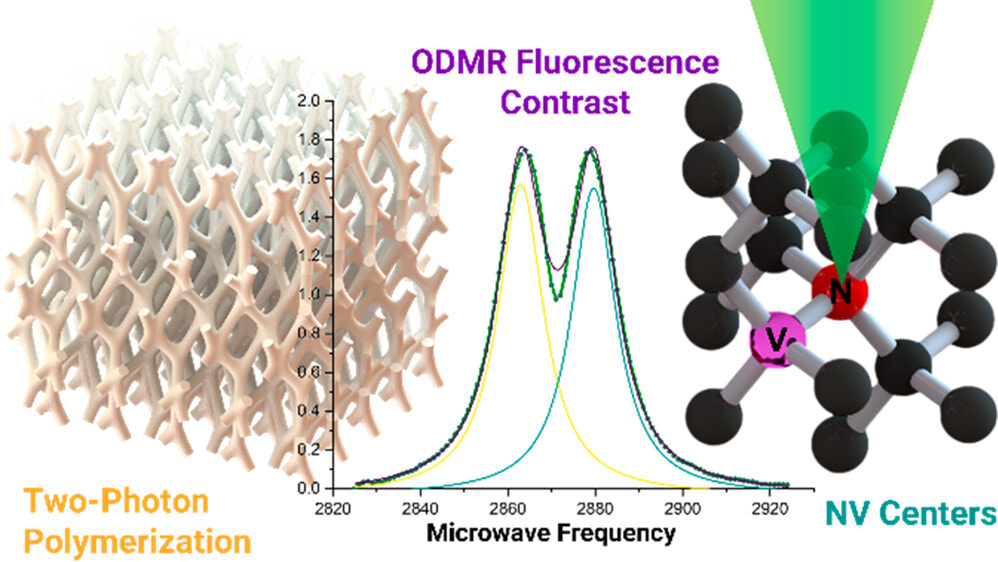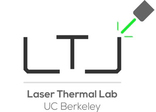Introduction
|
|
News
|
PhD Candidate Brian Blankenship along with Post Doc Jingang Li demonstrate the utility of bubble printing to selectively pattern nanodiamonds onto a 2D plasmonic substrate. They create intricate patterns of nanodiamonds with micro-meter level feature sizes. Beyond patterning, they employ a lock-in widefield imaging method to map microscale 2D temperature profiles generated from laser heating. This work was published in Nano Letters,
https://doi.org/10.1021/acs.nanolett.4c02519 |
|
The self-organized coexistence of metallic and insulating phases in strained vanadium dioxide (VO2) has been previously observed, but the nanoscale visualization of these phase domains has remained challenging. PhD student Rundi Yang and postdoctoral fellow Jingang Li investigated the strain-modulated phases and carrier dynamics in VO2 nanobeams with the transient near-field nanoscopy. They demonstrated the nanoimaging of the alternating triangular-shaped phase domains on bent VO2 nanobeams, which have a feature size of approximately 200 nm. Through pump-probe s-SNOM measurements, they discovered that the metallic phase of VO2 exhibits slower carrier recombination and faster carrier diffusion compared to the insulating phase. These findings are crucial for the development of VO2-based sensing and microelectromechanical devices and further investigations into strongly correlated materials. This work was published in ACS Photonics, https://pubs.acs.org/doi/10.1021/acsphotonics.4c00848
|
|
PhD students Brian Blankenship and Timon Meier, have developed a non-destructive confocal microscopy technique to image internal defects in complex metamaterial structures with micro- and nanoscale architectures. Metamaterials often exhibit enhanced and unconventional properties compared to their bulk counterparts. By carefully incorporating defects into the microstructures of these materials, unique, and sometimes enhanced properties can be achieved. However, manufacturing defects can be problematic when their specific, uncontrolled incorporation is paramount to a material's functional properties. The team demonstrated the ability of confocal microscopy to non-destructively precisely locate and visualize a range of intentional incorporated defects inside of metamaterial lattices. This method not only enhances the existing array of diagnostic techniques but also opens the door for adapting and applying similar strategies during the fabrication process itself, enabling the in situ detection and characterization of defects. The work has been published in ACS Applied Engineering Materials, https://pubs.acs.org/doi/10.1021/acsaenm.4c00160
|
|
Exciton dynamics plays a critical role in the functionality of two-dimensional (2D) materials and devices; however, the measurement of nanoscale excitonic behaviors remains challenging. Postdoctoral fellow Jingang Li and PhD student Rundi Yang reported a near-field transient nanoscopy to probe exciton dynamics beyond the diffraction limit. Exciton recombination and exciton-exciton annihilation processes in monolayer and bilayer MoS2 are studied as the proof-of-concept demonstration. Moreover, with the capability to access local sites, intriguing exciton dynamics near the monolayer-bilayer interface and at the MoS2 nano-wrinkles are resolved. Such nanoscale resolution highlights the potential for fundamental investigation of exciton physics and further optimization of functional devices. This work was published in Advanced Materials, https://doi.org/10.1002/adma.202311568
|
|
Transition metal dichalcogenides (TMDCs) with high refractive index at the near-infrared wavelengths are predicted to have superior performances in photonic devices compared with conventional semiconductors. Postdoctoral fellow Jingang Li and PhD student Rundi Yang investigated the optical waveguiding properties of colloidal MoS2 nanowires by scattering-type scanning near-field optical microscopy (s-SNOM). The combined experiments and simulations showed highly tunable waveguide modes, which can be modulated by nanowire thickness, incident wavelength, and environmental temperature, highlighting the potential for active optical components and integrated photonic devices. This work was published in Advanced Functional Materials
https://onlinelibrary.wiley.com/doi/10.1002/adfm.202312127 |
|
PhD students Brian Blankenship and Timon Meier, along with undergraduate Naichen Zhao, have developed a technique to image internal deformations in polymeric metamaterials using confocal microscopy. Many metamaterials are composed of complex micro- and nanoscale architectures that give these materials enhanced, and often unnatural material properties over their bulk counterparts. While SEM is commonly used for high-resolution imaging of such small-scale features, its limitations in probing deep within these materials hinders our ability to understand their internal behavior. In turn, we demonstrate an optical confocal microscopy-based approach that allows for high-resolution optical imaging of internal features, deformations and fracture processes in microscale metamaterials under mechanical load. The work has been published in Nano Letters, doi.org/10.1021/acs.nanolett.3c04421
|
|
PhD students Timon Meier, Jacky Li, Stefanos Mavrikos and Brian Blankenship, in collaboration with former LTL PhD student Zacharias Vangelatos and Dr. Erden Yildizdag from Instabul Technical University, have demonstrated new ways to inverse design metamaterials with tailored elastic properties. The research introduces a methododology that combines automated modeling, FEA, multi-objective optimization, 2PP fabrication and experimental validation. Utilizing their flexible framework, they successfully developed metamaterials featuring both isotropic and auxetic properties, offering new potential in material science and engineering applications.
The work was published in npj Computational Materials, https://doi.org/10.1038/s41524-023-01186-2 |
|
The quantitative analysis of s-SNOM experiments usually relies on analytical models, whose accuracy can be impaired by simplifications made on the system. PhD student Rundi Yang and postdoctoral fellow Jingang Li developed a numerical approach to study the carrier dynamics in pump-probe near-field nanoscopy, which could directly simulate the time-resolved near-field response and bypass the limitations of the analytical models. This method provides a validated and versatile framework to investigate the carrier behaviors in a broad range of semiconductor materials. The work was published in Journal of Physical Chemistry C,
https://pubs.acs.org/doi/10.1021/acs.jpcc.3c06824 |
|
PhD Student Brian Blankenship develops a method for incorporating and imaging nanodiamonds containing NV centers into two photon polymerization structures. He then demonstrates how these particles can be used for taking precise measurements of temperature and magnetic field in microscale environments. This has significant applications in the field of quantum information science for building practical sensors that work at room temperature. The work has been published to Nano Letters,
https://pubs.acs.org/doi/epdf/10.1021/acs.nanolett.3c02251 |
About
|
The Laser Thermal Lab is directed by Prof. Costas P Grigoropoulos of the Mechanical Engineering Department, UC Berkeley. Current research interests are focused on laser materials interactions, nanomanufacturing and the fundamental study of microscale and nanoscale transport phenomena.
Learn more about LTL |
Some Recent Publications
|
For a full list go to the Publications/Journals
|



